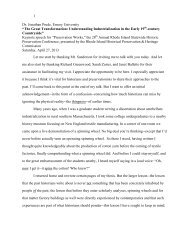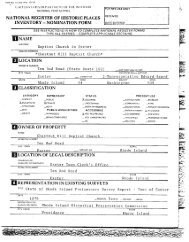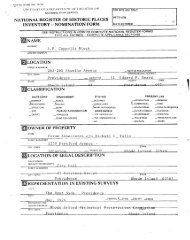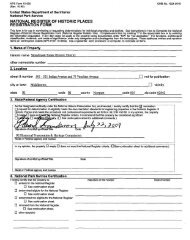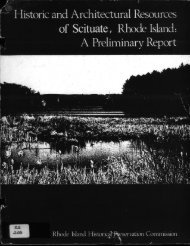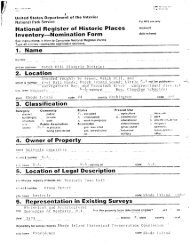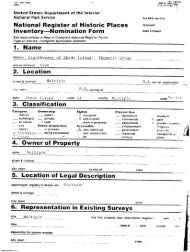National Park Service - Rhode Island Historical Preservation ...
National Park Service - Rhode Island Historical Preservation ...
National Park Service - Rhode Island Historical Preservation ...
Create successful ePaper yourself
Turn your PDF publications into a flip-book with our unique Google optimized e-Paper software.
- <strong>National</strong><br />
0MB PC 024-0018<br />
NPS Form 0-900-a Ezp- 10-31-84<br />
3-52<br />
United States Department of the Interior<br />
<strong>National</strong> <strong>Park</strong> <strong>Service</strong><br />
Register of Historic Places<br />
Inventory-Nomination Form<br />
Continuation sheet 4 Item number 7<br />
Page 5<br />
As a product of the growth and prosperity of the Peace Dale<br />
Manufacturing Company, village development closely paralleled<br />
that of the mills. This heritage remains intact and legible.<br />
The Company flourished in the seven decades between incorporation<br />
in 1848 and sale out of Hazard ownership in 1918. Of the 180<br />
buildings, objects and sites in Peace Dale, only about ten<br />
predate 1848, fewer than 30 postdate 1918. The major growth<br />
period was circa 1860-1895. Fully half the 180 properties date<br />
from that period. The detailed 1895 map of Peace Dale shows 115<br />
buildings not counting dependencies standing at that time; over<br />
100 survive.<br />
The unity of design characterizing Peace Dale architecture,<br />
in the broadest terms, can be defined as a certain reticence, a<br />
lack of showiness, which is pervasive. The only building which<br />
has something of a hint of bluster to it is the mill office<br />
#37A, once the nerve center of the community, and very aptly<br />
its physical center as well. The brick and stone building’s twotone<br />
color scheme, eccentric chimney, overwrought cornice and<br />
stained glass transoms are held in check by its ponderous<br />
proportions, symmetry, and small size. Other Peace Dale<br />
buildings are more soberly handsome. They can be subdivided into<br />
two major classes: mills and civic buildings, and residential<br />
architecture. Together they define the visual character of the<br />
village. The five village schoolhouses, while interesting<br />
individually and possessed of considerable design quality, are a<br />
disparate lot and do not add to the unity of, design under<br />
discussion; rather, they provide interesting, widely dispersed<br />
contrasting accents. Peace Dale mills and civic buildings, and<br />
village dwellings are consistent in materials: all the former<br />
are built of local gray granite, all the latter are of frame<br />
construction. As a rule, and this applies to all building types,<br />
the attributes of period-style are lacking or, very under-played..<br />
Thus the "Richardsonian Romanesgue" of the Hazard Memorial #38<br />
is not so pronounced as to dissociate this building from the<br />
styleless mills across the road #37, or the nominally<br />
"Colonial" Neighborhood Guild #94 on the opposite side of the<br />
Green. . -<br />
There are a great many more residential buildings in Peace<br />
Dale and naturally greater variety of design, but one type<br />
predominates: The L-plan, 1-1/2-story, gable-and cross-gable<br />
cottage with a 2- or 3-bay, end-gable main block containing the<br />
entrance, and a lateral kitchen ell sometimes with a lower roof<br />
height fronted by a porch. Sudh cottages comprise a quarter of<br />
the residential building stock. They are found on nearly every







